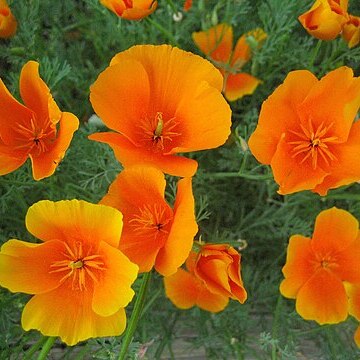Annual or perennial, caulescent or subscapose herbs from taproots; sap colourless or orange. Stems sparsely leafy above base. Leaves alternate to subopposite; basal and lower cauline leaves petiolate; upper cauline leaves subsessile or sessile; lamina 1–3 times ternately dissected; margin entire. Inflorescences cymiform, bracteate, 1–many-flowered; buds erect or (not in Australia) nodding. Flowers: hypanthium surrounding the ovary base, bearing perianth and stamens sub-perigynously from beneath a flaring free rim. Sepals 2, connate, calyptrate, caducous as a unit. Petals usually 4. Filaments basally adnate to petals, stout, usually shorter than anthers. Ovary 1-locular; style short to obsolete; stigmas usually 4, unequal. Capsule erect, elongate, terete, ribbed, 1-locular, 2-valved, deciduous, dehiscing explosively from base on separation. Seeds many, reticulate or (not in Australia) minutely pitted; aril absent.
Herbs , annual or perennial, scapose or caulescent, from taproots; sap colorless or clear orange. Stems leafy. Leaves alternate, basal and sometimes cauline, petiolate; blade 1-4× pinnately deeply lobed, lobes of each order usually 3; ultimate lobes narrow. Inflorescences terminal, cymose with bracts present, or 1-flowered. Flowers: receptacle dilated, forming cup beneath calyx, sometimes with free rim; perianth and androecium perigynous; sepals 2, connate, calyptrate, deciduous as unit; petals 4, rarely more (doubled flowers), obovate to obcuneate, with satin sheen from microscopic linear grooves; stamens 12-many; pistil 2-carpellate; ovary 1-locular; style absent; stigmas 4-8, spreading, linear. Fruits capsular, cylindric, 2-valved, dehiscing from base along placentas, often explosively. Seeds many, tan, brown, or black, spheric to ovoid, reticulate, ridged and burlike, or pitted, aril absent. x = 6, 7.
Annual to perennial herbs with watery sap. Lvs dissected, glabrous, glaucous; segments linear. Fls solitary or in lax leafy cymes. Sepals 2, entire, not horned, joined in the bud to form a hood pushed off by the opening petals. Petals 4, not crumpled in bud, orange to yellow, sometimes white or red. Stigma with 4-6 long spreading lobes; style very short. Capsule linear, 1-celled, opening from below by 2 valves which separate from the placentae. Seeds ellipsoid or circular, without aril.

